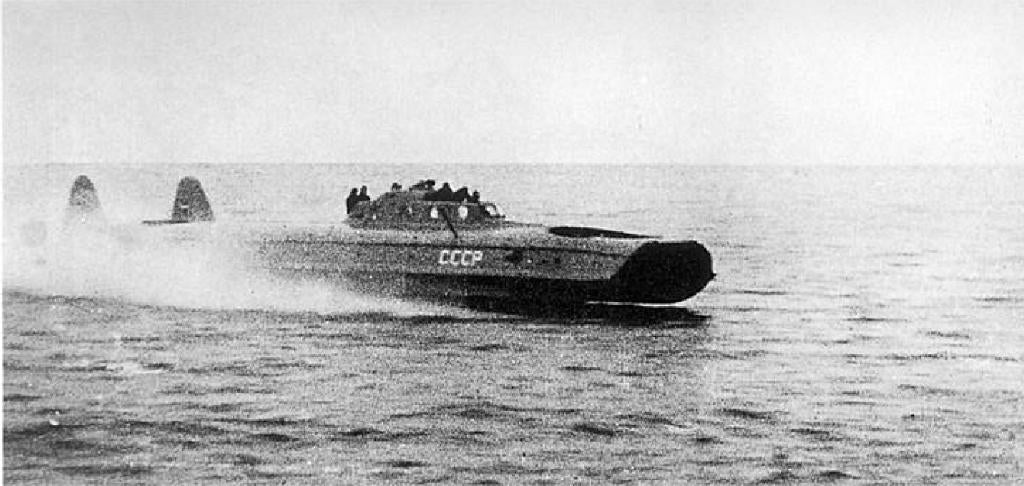If you look up “first hovercraft” online, the top results state that the first viable hovercrafts were developed by British inventor Christopher Cockerell in the 50s and 60s. Unless you look hard, you won’t see the name of a Soviet inventor: Vladimir Levkov. This bright spark invented a working hovercraft in the early 1930s, and by 1939, it was operating in the Red Navy. Like so much of Soviet history, this story is mostly forgotten.

The Man Behind the Machine
The hovercraft’s creator, Vladimir Levkov, was born in 1895 in the industrial city of Rostov-on-Don. He graduated from the Donskoi Polytechnic Institute (located just outside the city) in 1921, and within eight years, was appointed a professor at the Applied Aerodynamics Department.
It was here young Levkov came across the work of Konstantin Tsiolkovsky, a Soviet aerospace pioneer. Tsiolkovsky was a true visionary and authored works on subjects as varied as interplanetary space travel, space station construction, and airship design. He also laid the theoretical groundwork for powered movement over a “cushion” of air.
At once, Levkov began theorising. By 1927, he had designed his first model. It was circular—like a flying saucer—with a huge fan at the centre. It wasn’t all that impressive at less than 1 metre across, but it proved Tsiolkovsky’s concepts were possible.
Levkov revised his design and had his next model ready in 1932. This one was 2.5 metres long and oval-shaped. It sported fans driven by aviation engines at the front and back. Levkov envisioned his hovercraft as a fast attack vessel for the Red Navy, and when he showed the admirals, they were impressed. They moved him to the Moscow Aviation Institute (MAI) and gave him a crack engineering team. His goal was to make military hovercraft a reality.
The First Hovercraft
Levkov’s first operational prototype was christened the L-1 in his honour. Its first tests were carried out in 1934, and the design proved to be a success. Essentially, the hovercraft was an oblong-shaped twin-hulled catamaran with forwarding and rear engines working in unison to create an air bubble underneath it. Over dirt, snow, and water, the experimental vessel could reach an average speed of 60km/hr—which was obscenely fast for 1934.
With the Red Navy admiral’s support, Levkov upgraded and improved his design. His next major prototype was the L-5, and this hovercraft was seriously souped-up.
Weighing in at 8.6 tonnes, this mechanical beast needed two 890-horsepower engines to get it up and to move. But flying on its cushion of air, they could propel the L-5 at speeds of 140km/hr (73 knots)! No contemporary Navy had a surface vehicle comparable in speed to Levkov’s hovercraft.
Mikhail Frinovsky, the People’s Commissar of the Red Navy, reported to his superiors that, “The trial results indicated that the tactical and technical characteristics of this new attack craft significantly surpassed those of fast torpedo craft in service with the Red Navy.”
It was well-armed too. The L-5 could launch torpedoes between its hulls, drop depth charges from the back, and be fitted with a twin machine-gun turret. The pilot had a separate compartment and behind him sat the engineer/gunner. In the back, a platoon of marines could be loaded aboard.
The admirals saw two key uses for this truly unique vessel. Firstly, as a speedy torpedo attack craft; secondly, as the fastest landing craft ever devised. By 1938, the Red Navy had put in an order for nine of them.

Polar Operations
Despite its successful tests, Levkov decided his design needed more work before it could be declared “battle-ready.” As he saw it, the problem was with the engines. In even marginally rough seas, sea spray got into the intakes and caused the hovercraft to stall. The aviation engines were also designed to operate at colder temperatures and overheated if run for extended periods.
Levkov kept tinkering with his prototypes but was never satisfied with his results. The Red Navy, on the other hand, were keen to press the hovercraft into service as soon as possible, and in 1938 some upgraded L-5s saw operational service.
An L-5 hovercraft was used to transport the four-man crew of North Pole 1, a Soviet arctic drift station, to an icebreaker after their research was completed. Near the end of the mission, the L-5 hit an ice mound and was severely damaged.
Sadly, this was the last mission for Levkov’s hovercraft.
Conclusion
By June 1941, Levkov still hadn’t ironed out all the kinks in his hovercraft design. But it was too late; when the Axis invasion of the Soviet Union got underway, he was forced to relocate to Siberia, leaving his experimental vessels behind. They were destroyed to prevent them from falling into German hands.
Levkov was transferred to aircraft design for the duration of the war. He never got to finish his hovercraft project. When he died in 1954, Cockerell was just beginning his research into hovercraft technology. He didn’t know it, but he was treading a path carved by Levkov decades previously.
Interested in other crazy Soviet inventions? Check out our awesome video covering some of Stalin’s insane pre-war projects:
